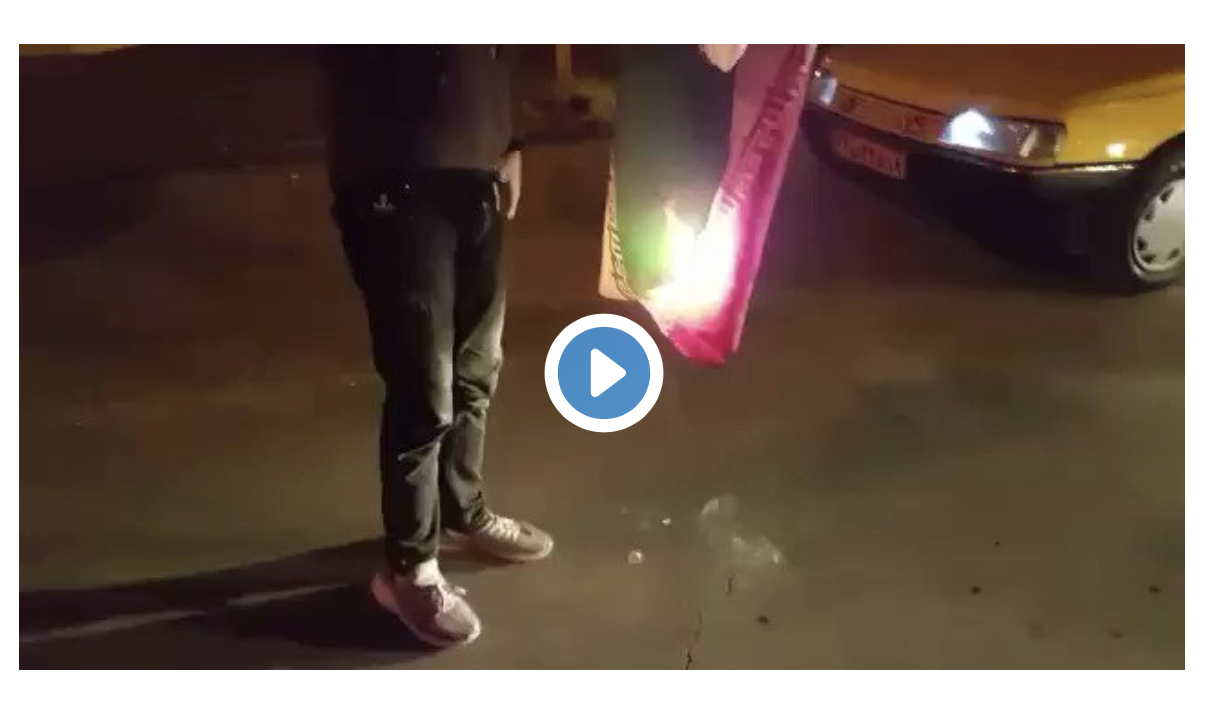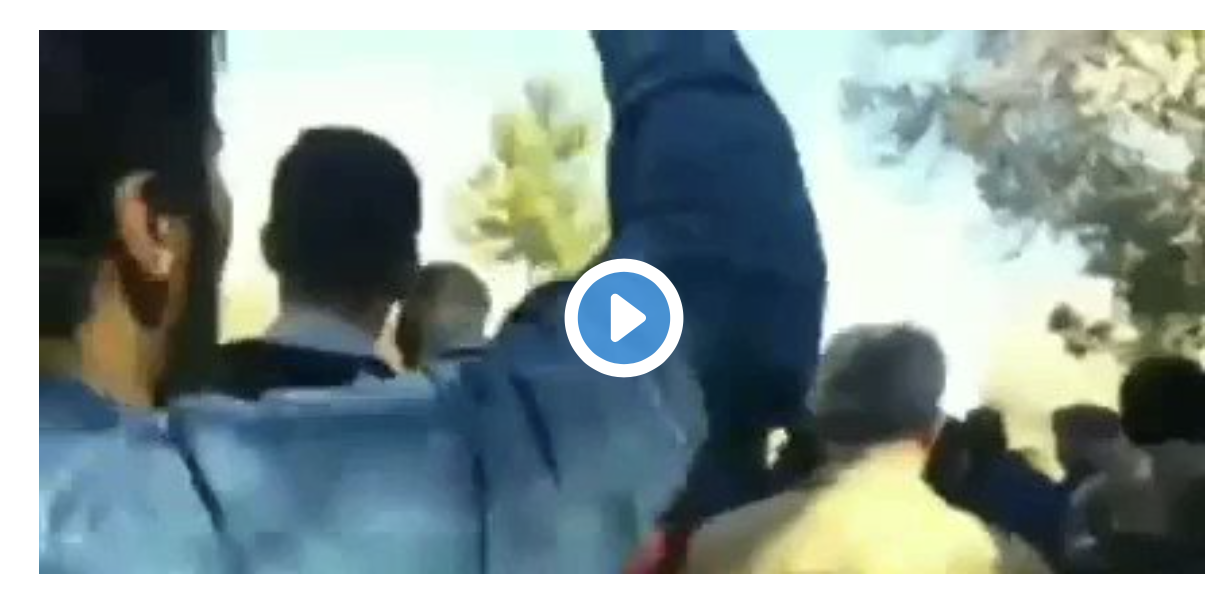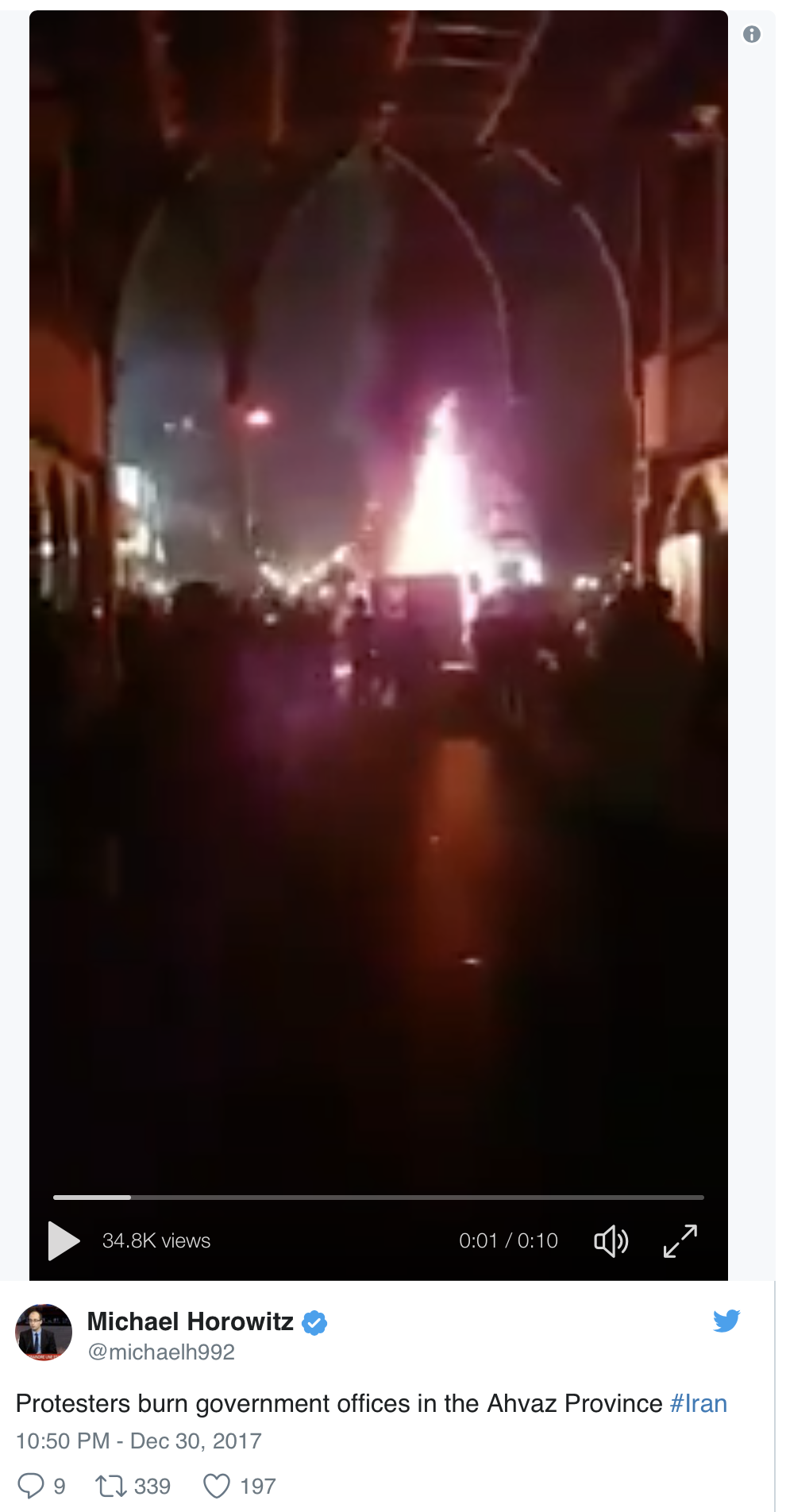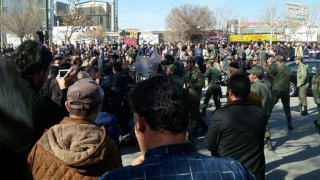IRAN PROTEST CRISIS: Everything you need to know
Across the websites of the Associated Press, Reuters, and the U.S establishment's own 'Twitter' and 'Facebook', news stories covering apparent violence in Iran and a radical change in the demands of protests have today sprang up, with a tone of extreme urgency.
So what's the problem? And why are Iranians protesting?
Problematic, however, has been any way to independently verify these claims. The Iranian government has generally been clear that there are two unrelated types of protests going on, simultaneously. However, these claims can only be juxtaposed to claims from Iranian 'activists' associated with the radical reformist Green Movement, originally of former Iranian PM Mousavi. But today are themselves divided, and a branch exists today aiding in organizing the smaller protests and 'stunts', which is organized in connection with US support.
But the other branch was actually reeled in, absorbed, tamed, and redirected by Rouhani under the auspices of the Ayatollah Khamenei. At the same time, this had the effect of bringing elements of radical reformism closer to vectors of power than they had been since the mid 1990's.
The elected government's official view, as reported internationally and by Iranian state media, is actually supportive of the legitimate demands of the mainstream protests. They have already announced this to the protesters, and are working at the level of civil society intervention to de-escalate the protests and usher in a series of new policies and programs aimed at ameliorating some of the legitimate concerns. Meanwhile, government supporters have also turned out en mass to counter the international image being projected by Western media.
With official unemployment at 12% and negative economic growth for a number of years until the 2016 GDP boom that saw 12% growth, without these gains properly trickling down, and a whole period of inflation which hasn't been recovered from yet (as sellers saw what price maximums were possible), what we are also seeing in Iran are real people protesting about real problems.
To be clear - the government of Iran is not blaming the legitimate protesters as 'Western agents'. They have said that the protests, correctly, are chiefly related to inflation and other economic related concerns. Rouhani himself has publicly stated that he shares precisely these concerns.
It isn't so easy simply to dismiss these complaints from the mainstream of protesters, and dismissively point instead to the economic encirclement the west has placed upon Iran. Iran is nevertheless still a class society with a wide and growing disparity between income groups. There are Iranian billionaires, private owners of firms and joint stock companies, who while operating within the parameters of Iranian sovereignty, also acquire their economic success on the backs of countless Iranians. Their wealth and stature in Iranian society grew significantly under Rafsanjani's tenure.
That some of these firms themselves are, or had been, the subject of sanctions, is not entirely relevant to the fact that the economic policies of some of the reformists have led to the enrichment of a few at the expense of many. And this is the discourse we are seeing and hearing from Iranians today. What therefore is being presented in Western media, is an inversion of reality.
If anything, a plurality of protesters would likely want to see a return to the policies of Ahmadinejad. Unemployment, for instance, was lowest under his administration. He also placed price controls, and subsidized other goods, in response to the spiraling inflation caused by western imposed sanctions.
Is there anything more we should say about this?
Indeed, opposition to the privatizing and anti-social policies of Rafsanjani, is where the Alliance of Builders of Islamic Iran comes from. Rafsanjani, president in the late 80's through mid 90's, was of course not entirely unsuccessful in any number of projects important to Iran, including increasing ties with post-Soviet central Asian countries. But significant to the average Iranian laborer or small shop keeper, were his anti-popular measures. So the economic leftism of the Alliance of Builders of Islamic Iran is a response to this, and Ahmadinejad rose to prominence in large part through this movement, which he leads.
All this leads to only one conclusion - the Western media is manufacturing a story, with little basis in Iran's reality and recent history.
So there is something very clear now we must understand about the legitimate mass protests, however, which is that they have nothing substantively to do with the solution set proposed by the Green Movement or, for example, the National Trust party of Karroubi (another prominent reformist). Western media would have you believe that all of this, what you are seeing, is homogeneous in its message, and reformist or even Green, in nature.
Now, understanding the political composition of the mass protests is not so easy - some of course are critical of Rouhani for not being reformist enough, and not open enough. They may parallel some of the demands and concerns of both wings of the Green Movement, or of Karroubi's National Trust.
What's the history here?
The Green's spiritual leader, who was also a leader of the 1979 Revolution, but later fell out of favor in the mid 80's for reasons we will mention now, is Montazeri. Montazeri himself was demoted and finally pushed out of leadership circles for having liberal criticisms of the Iranian Revolution, and also opposed the regionalization or exporting of the revolution.
So these are themes from the 80's, which still in some prominent ways are dominating the internal debate within Iranian society today.
So who is protesting?
The vast majority of protesters are either not particularly partisan, or they are - contrary to how the western media blitzkrieg over the last 48 hours has painted it - sympathetic to Ahmadinejad's criticisms of reformist economic and foreign policy, insofar as this is a policy which has favored an increased polarization of the distribution of wealth and opportunities in the Islamic Republic. So their chief issues are economic concerns, corruption, and distribution of wealth and human services. There is enough sophistication in Iran to understand that in terms of regional politics, everything Iran does in Syria and Iraq is an important move to counter and contain Israel. This is a 'popular militancy' that is carried on from the revolution of 1979 itself.
So to understand Rouhani, he has pursued a very similar foreign policy - in effect - as the conservatives and 'revolution exporters', as seen in the way that Iran today supports Shiite brigades in Iraq and Syria, and also has their own special forces fighting there in Syria and Iraq, as well as very close support and funding for Hezbollah in Lebanon. Again, these are contrary to what both the Green movement reformists, National Trust reformists, and run-of-the-mill moderate reformists want.
But the economic policy pursued by Rouhani - with a following proviso - has been that of the reformists. That policy has been to have warm economic relations with the west. While there are some divisions there about whether Europe or the US would be a better partner, nevertheless this has been pursued, and for that we saw the government of Rouhani enter into the anti-nuclear agreement that was supposed to be the pathway out of sanctions - one that has, with mixed results, generally worked.
And internally, that policy, again, favors the individual rights of owners and bosses against the middling and lower classes.
Yet the proviso we must insert here, is that the economic policy of the reformists, in their eyes, isn't responsible for the economic crisis - they view and criticize Rouhani for not in fact succeeding in opening up ties as much as they could be.
Sanctions is a somewhat misleading framework to understand an underlying fact, which is that there is no mechanism or impetus to force seller and buyers in two countries to come to terms, and there are plenty of mechanisms within a country hostile to Iran to nudge its firms not to trade with Iran, even if 'sanctions' are not in place. In this way, we can understand the significance of sanctions, but also understand all of the more complex realities that may fall under that general concept, while not being in fact 'sanctions' per se.
Membership in the WTO, for example, would work to overcome the problem of this de facto category of sanctions, but the US has blocked Iran's entrance since reformists pushed for its application in 1996. But just a few months back in September 2017, Iran announced it was officially withdrawing its application. This was a major turning point, and a very 'anti-reformist' move by the ostensibly reformist Rouhani.
Two unrelated protest movements happening
In other words, there are at least two sets of protests going on, and while they are mirroring some similar talking points and general descriptions of grievances, their solutions are wildly at odds. We should note that in the north-west of the country, where there have been numerous but small protests, among the demands are a mixture of populist and left economic demands, with greater autonomy demands which mirror the reformists - the later of which the US would very much support as it creates opportunities and pretexts, the likes we have seen in places as far and away from each other as the former Yugoslavia and Syria re the Kurdish question.
To understand this: imagine genuine socialists and genuine libertarians both protesting in the U.S about the failures of the public education system, with socialists urging greatly more funding, and libertarians urging that the system be abolished -- literally opposite solutions to the same identified problem.
That's how we might better understand what we are seeing today with the various protests in Iran.
With the more radical wing of the Green Movement (et al, and similar), we see them pulling off various stunts. These are stunts, and not protests as such, because they involve at most several dozen 'activists' using camera angles, and unpopular chants, to simulate a larger protest with, what we are told are, popular radical chants.
This simulation of reality is only possible using a combination of western media hyperventilated coverage surrounding demonstrably isolated events carried out by less than a dozen individuals. A 'twitter storm', is being used - this is a centrally planned weaponized information method - and is essentially what one would conceive it to be, by its designation.
These are astroturf, not grass-roots type demonstrations.
Here, above, we see a 'protest' calling for regime change. Seems like serious stuff, until your eyes adjust to the way the camera is framed, and realize that all the people doing this stunt are in fact just those in the frame.
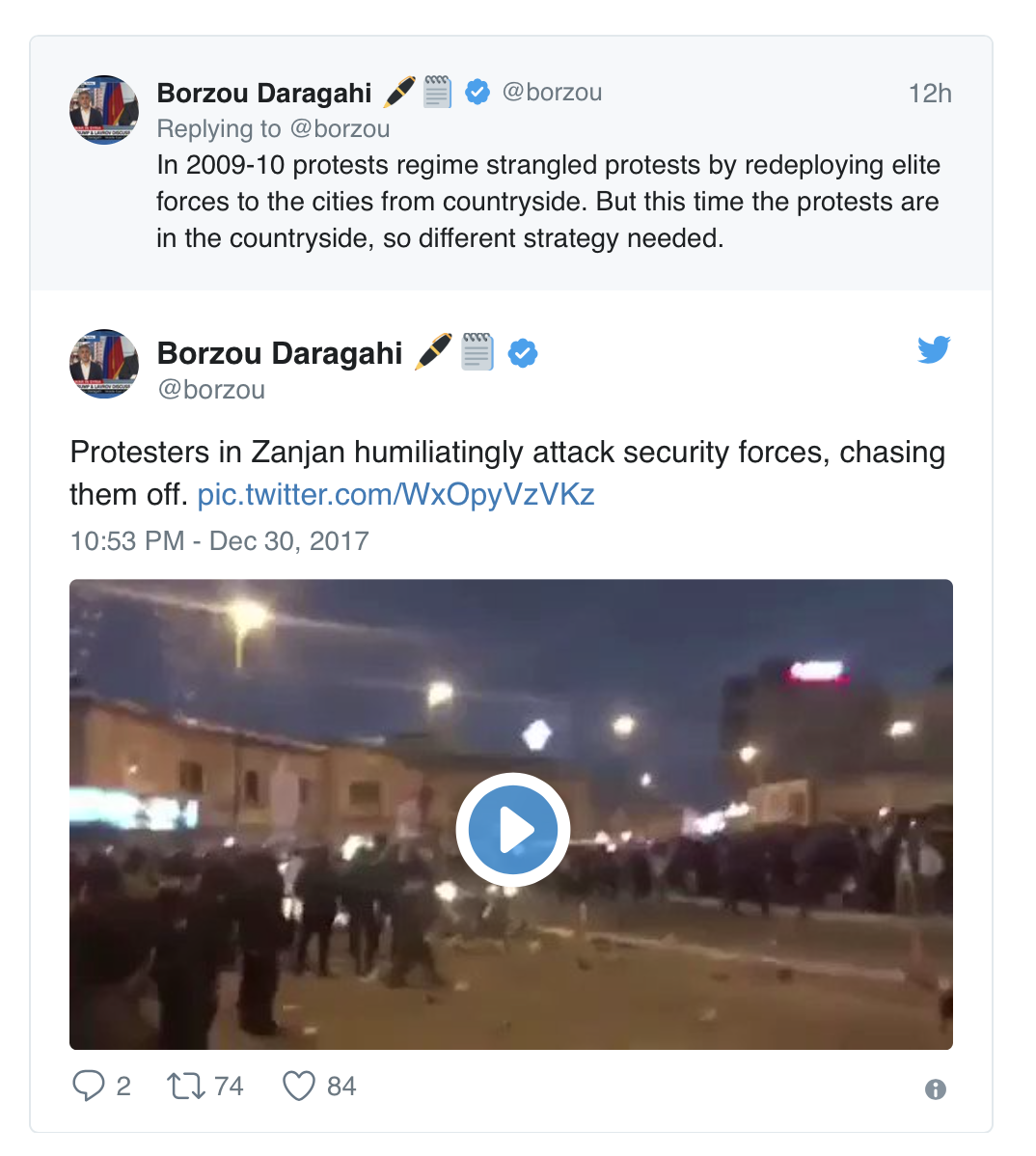
Is Daragahi suggesting that the security forces should avoid this imaginary 'humiliation', and instead repress the demonstrators? Orders from central government have been clear - treat all of these with as light a hand as possible. If protesters seem to be irrationally targeting local police, there to generally maintain order, then its better to relocate or withdraw those police rather than have them actually employ their obviously superior force potential, and give reality and proof to, what are until now, imaginary accusations of a serious crack-down going on in Iran (there isn't one).
In this one, above, we see a US state department shill interpreting events in the standard way that the Color-Spring tactic attempts to. They want to goad, to provoke the police into making a kind of public attack, a sort of realized crack down - the sort they are already saying is happening, but don't have any real proof yet to show.
Would any sane person, who didn't want to antagonize or inflame the situation, frame what we are seeing here, in this way? Are the security forces being 'chased off'? They are armed, the protesters are not. We see them moving. Are they moving in somewhere, or moving out of it? We do not know from the actual footage. Are they being attacked? We counted three to four, of what look like, toilet paper rolls, or similar light white objects, being lobbed by what can't be more than one or two provocateurs.
In this final example, we have another case of the text of a tweet making 'news', but the content of the actual video is telling another story. Far from a 'government office' being burned, it appears to be an out-door bonfire, in a plaza or on the street, perhaps in front of a government office, and perhaps simply in that proximity, or perhaps nowhere near that.
Therefore, similar reports of government buildings being 'occupied' should be treated with skepticism, even if they are accompanied by 'video'. We must remember to use our own brains, when we use our own eyes, to look at purported events.
Other video clips circulating on twitter, are remixes and image inversions, of cell phone recorded events from 2009.
Astro-turfed demonstrations, placed explosives elsewhere, and perhaps next snipers creating chaos in one of the seven countries on the Pentagon's regime change list of 2001, have one thing in common: it's signature most likely being "CIA".
On the other hand, at least an equal number of people have turned out in today and yesterday's pro-government demonstrations, photo below.
Finally to contextualize the reality of any Western media purported 'crackdown' - what we are seeing in Iran today is only a fraction of what we saw in terms of seriousness or size, in 2009. In 2009, about 200 protesters were ultimately arrested. We might compare this to the 'open' and 'pluralist' United States, were Occupy Wall Street protests saw a police-state figure of over 8,000 arrested.
http://www.fort-russ.com/2017/12/iran-protest-crisis-everything-you-need...


